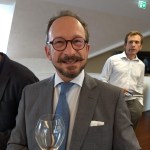File Edit View Insert Format Tools Table Paragraph
I’ve been updating the Trade News page of this website where I have detailed harvest reports going back until 2006 and looking at the original assessments – done with the winemakers’ feedback in the autumn just after picking is completed — of the best vintages of recent years in Champagne. I had to give a marks out of ten assessment for each new addition of Oz Clarke’s Pocket Wine A-Z and checking in the 2015 guide, between 2004 and 2013 we gave four vintages 8 out 10, the highest mark in this decade.

The most recent of these was 2012, and now as more wines from that year are released, my harvest time assessment definitely looks a little on the mean side. There were some pretty effusive comments made at the time, despite the mostly disastrous growing season with frost, poor flowering, hail and disease all hitting yields. Quality was saved by very sunny weather immediately pre-harvest in mid-August, that continued into the first week of picking.
“It is a great vintage. Probably better than 1996 and close to 1990 on average. But in some special location it could well be better than that, closer to a 1947,” said Jean-Baptiste Lécaillon chef de cave at Louis Roederer.

“For us [it is], somewhere between 1959, 1990 and 2002. Yields were only 6 to 7000 kilos/hectare, but quality was very satisfactory, especially the Pinot Noir,” said Charles Philipponnat of the eponymous house.
“Everything is here, quality-wise, to craft some top vintage champagne. It looks like a cross between 2002, 1990 and 1952 all excellent years,” said Frédéric Panaïotis, chef de cave at Ruinart.

“The overall quality of the grapes was very high,” says Hervé Deschamps, chef de cave at Perrier-Jouët. It was “a very good healthy harvest with no botrytis and a very good ripeness for all grapes varieties.”
While Benoît Gouez, chef de cave at Moët & Chandon was “very confident in the vintage potential of this harvest”. Slightly more cautiously, Dominique Demarville, who was at that time head winemaker at Veuve Clicquot, said: “On the paper, this year looks very good, close to 1990, 1989 and 2002 for the level of sugar, with the acidity level not too far from 1998, 1990 and 1982. It could be a very nice vintage, but we must wait to taste the wines, which we start next week.”

Eight years on and most of these houses have released cuvées of this vintage with impressive results, but wines that are yet to reach their peak. It’s been very interesting in lockdown to sample more recently released examples from Charles Heidsieck and Krug, the latter in the shape of Grande Cuvée based on this harvest.
For Charles Heidsieck, 2012 follows 2005, 2006 and 2008, the last two vintages made in fairly small volumes, partly because the house was still run then by Remy-Cointreau who were looking to sell the brand (as they had sold Krug a few years earlier). There is therefore a suspicion that the 2012 has come to the market slightly earlier than it might have. But as current winemaker Cyril Brun says – this wine was actually made by his immediate predecessor Thierry Roset who sadly died in 2014 – it has the balance to carry this off (see full review of both wines on What I’ve Been Tasting page).
The latest release of Krug Grande Cuvée, the 168th Edition, is also based on the 2012 harvest, which accounts for over half the blend, or to be precise, 58%. Krug has over the years been at pains to says that its flagship Grande Cuvée is a uniformly consistent product, whatever the vintage base may be.
To demonstrate the apparent truth of this, Olivier Krug is fond of recounting the blind tasting a few years back where the senior members of the tasting panel — himself, previous chef de cave Eric Lebel and the newly promoted Julie Cavil — lined up a number of blends of Grande Cuvée based on six different vintages, a range running from 1998 to 2003, a pretty interesting and diverse collection of harvests.
When they voted for their favourite blend in the line-up, “We all three picked the blend based on the 2001 harvest as our favourite, despite this being the poorest harvest by some way of the six we tried,” says Olivier Krug.
However, the very fact that Krug has started more readily revealing the harvest base for each release through its ID code and has now gone one step further by giving each new blend an edition number (a practice which started only in late 2016 with the release of the 163rd Edition, based on the 2007 harvest), is a tacit admission that blends do vary. And those based on particularly fine harvests are almost bound to be more popular among the Krug fanatics, who want to buy every version of the Grande Cuvée blend to contrast and compare.
These two wines, although they have entirely individual taste profiles, demonstrate in their different ways is there’s no hurry to drink up this vintage, which is still only at the start of a drinking window that might easily last two further decades or more. They will improve with more time in bottle and offer substantially more nuances of flavour and texture, as great champagne does. But they also show the innate drinkability of a vintage that shows a lovely balance between ripe fruit and fresh acidity, that makes it attractive now.







